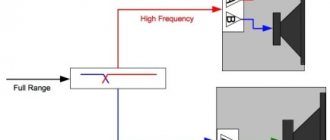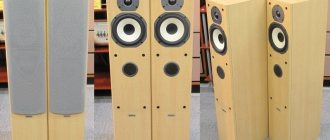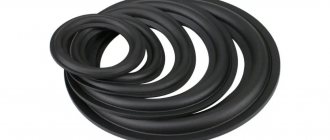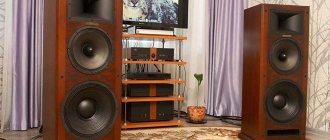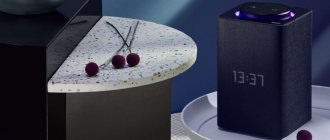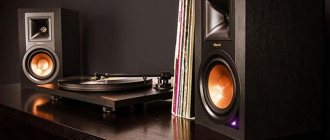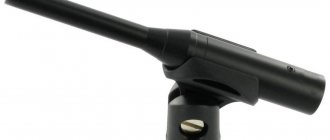In addition to damage to the suspension, diffuser and mechanical particles getting into the gap of the magnetic system, owners of acoustic systems sometimes have to deal with a more serious defect. This is a DIY speaker rewind. More precisely, its voice coil. In rare cases, it is necessary to rewind a working coil, if this is required by matching the speakers with the low-frequency amplifier. Rewinding requires complete disassembly, except for the magnetic system. The main electrodynamic heads used in household appliances do not have a dismountable design. Only high-power heads used for sounding large areas allow repeated dismantling and subsequent reassembly.
How to rewind a speaker with your own hands
If the loudspeaker of the acoustic system fails, you should not immediately remove it and start disassembling it. Often the cause of failure is a simple break in the connecting wires in the speaker or the conductors running from the audio winding to the speaker contacts. Only after checking all circuits using a tester can you begin dismantling. To remove the speaker coil, you need to perform a series of operations sequentially. All work should be carried out on a comfortable table. First you need to remove the speaker from the speaker system by unsoldering the connecting wires and unscrewing the mounting screws. Then unsolder the conductors coming from the audio winding to the terminal block. This must be done very carefully, since the connecting conductors have a rope structure, where thin copper strands are intertwined with thin cotton threads.
How speaker coils are wound
Replacing or rewinding a speaker coil with your own hands begins with peeling off all the elements of the moving system. First you need to dismantle the dust cap or membrane, which is dome-shaped and located in the central part of the diffuser. In order to separate it without damage, apply a solvent to the gluing area around the perimeter of the cap. You can use a plastic syringe with a needle with a sharpened tip. The solvent is poured into the syringe and applied in a thin strip to the gluing area. The solvent must be applied very carefully so that it does not spread over the surface of the diffuser. It is not recommended to use a brush for this purpose, as hair may come off and get caught in the gap of the magnetic system.
Adhesive compositions may differ on different models, so it is best to start with alcohol and then move on to more active substances, such as solvent 646 or acetone. To prevent rapid evaporation of the solvent, after application, the dynamic head must be placed in a plastic bag. After 10 minutes, the membrane is easily separated using a thin plate.
Rewinding speakers
In addition to damage to the suspension, diffuser and mechanical particles getting into the gap of the magnetic system, owners of acoustic systems sometimes have to deal with a more serious defect. This is a DIY speaker rewind. More precisely, its voice coil. In rare cases, it is necessary to rewind a working coil, if this is required by matching the speakers with the low-frequency amplifier. Rewinding requires complete disassembly, except for the magnetic system. The main electrodynamic heads used in household appliances do not have a dismountable design. Only high-power heads used for sounding large areas allow repeated dismantling and subsequent reassembly.
Winding the speaker coil
Next, you need to peel off the diffuser in the same way. The perimeter of the acoustic reflector is quite large, so it should be separated gradually. First, a small area is generously saturated with solvent. After some time, when the solvent is absorbed, you need to use a thin and sharp plate to separate the edge of the diffuser from the metal basket. To prevent it from sticking back, a thin plastic plate is placed under it. Gradually the entire perimeter is processed in this way. The next stage of disassembly is the separation of the central suspension. This is not always possible to do. This structural element can be glued so reliably that even prolonged treatment of the gluing area with a solvent does not always lead to the desired result. In this case, you will have to cut off the central suspension. This must be done with a very sharp object and as close to the gluing site as possible. Then the structure can be restored without problems. After the diffuser along with the sound winding is removed, you need to seal the gap of the magnetic system with tape to prevent any mechanical particles from getting there.
Do-it-yourself speaker coil winding repair usually involves two operations. This is the restoration of “flying” turns and complete rewinding of the product. It happens that measuring the winding resistance shows that the winding is intact, but some turns have become unstuck and create an obstacle to its normal movement in the magnetic system. In this case, you need to carefully put the coils in place using tweezers or another tool. The work is painstaking, labor-intensive and time-consuming. It is best to lay and align 1-2 turns, fixing them with glue. BF-2, BF-4 or any alcohol-based adhesive is used as glue. As a last resort, the wire for the speaker coils can be fixed with nitrocellulose-based glue. If during operation the thin wire breaks, you will have to rewind the speaker coil, completely removing the old winding.
Device and troubleshooting
Subwoofer 5, 1 consists of a speaker, speaker, and amplifier, as well as a power supply:
- An acoustic speaker usually fails only from mechanical damage.
- Failure of the dynamic head is caused by the contact of its coil with an audio frequency with a power for which the head is not designed, or with constant voltage, which causes the coil to burn out
- When listening to a speaker with amplification at maximum power, you will encounter the problem of wear (rupture) of the driver cone
- If the speaker breaks, it must be replaced, since rewinding the coil or repairing the subwoofer diffuser is a delicate, painstaking job and it is very difficult to do it efficiently so that the sound does not deteriorate
First you need to find out which element of the subwoofer failed:
- A common cause of power supply failure is impaired heat exchange.
- The huge amount of dust that gradually accumulates inside the unit causes the parts to overheat and cause them to fail.
- Using a tester, we check whether there is voltage at the output of the power supply; if there is no voltage, then you can be sure that the reason lies therein
- When inspecting the parts of the power supply, you may find swollen capacitors or blackened transformer windings
- Using a soldering iron, unsolder damaged parts and replace them with new ones purchased at the store.
- You can rewind a burnt-out transformer with your own hands if you already have experience in such a matter; if you have no experience, it’s better not to take it on, or practice on something you won’t mind
- If there is voltage at the output of the power supply and it does not deviate from the specified norm, then you can move on to the low-frequency amplifier
- A board with an amplifier is a place where, as a rule, there are a lot of transistors and microcircuits. Using a tester, carefully touch the outputs of the microcircuits, measure the voltage
- When they are cold at normal supply voltage, there is probably no current in them, it should warm them up
- If the chips are hot on the contrary (they are usually slightly warm during normal operation), this is a sign of a malfunction
- Using the same analogy, we check all capacitors, swelling, hot surfaces are symptoms of their unstable operation
- The diffuser can be sealed with a back strip of tape, (preferably thin cardboard) the edges, while the edges of the material being glued need to be thoroughly coated with rubber glue so that the glue sticks out on the surface of the diffuser, repairing the subwoofer suspension (see How to glue a subwoofer so as not to buy a new one) this is complete
- Dry it for a day, then check the operation at low and medium power; if the sound is bad, it’s easier to replace the entire speaker than to bother with replacing the diffuser
- Replacement is a long, labor-intensive process that does not provide any guarantees of high-quality sound, plus - one careless movement, and the new diffuser will also be destroyed.
How to make a speaker winding
Winding speaker coils is a delicate and responsible job. Whether the loudspeaker will work or will have to be thrown away depends on the quality of its implementation. First, the old winding should be wound, while counting the number of turns. This data will be useful for winding a new product. If the wire has not burned out or crumbled, you can not count the turns, but measure the length of the wire. Then its diameter is determined with a micrometer and, based on these data, the wire for rewinding the speaker is selected. It often happens that the paper sleeve is badly damaged. In this case, you will have to not only change the winding, but also make a new frame yourself. In order for the production of the sleeve and winding to be successful, you will definitely need a mandrel on which these works will be carried out. Using a mandrel will make the work more convenient and prevent the paper core from deforming during the winding process. If rewinding speakers with your own hands is a one-time operation, then a mandrel of the required diameter is made from any material that can be easily processed. Those who regularly repair loudspeakers will need a set of metal split mandrels.
The cut is needed so that the mandrel can be slightly compressed and the finished product can be removed from it.
Rewinding the speaker voice coil
When loudspeaker systems are operating efficiently at maximum volume levels, it is rare for a sound system to burn out neatly and in one place. Usually, after disassembling the loudspeaker, black and charred coils are visible. If the frame is made of paper, then it also burns badly and needs to be replaced. Special paper is used as material for the sleeve. There cannot be specific recommendations here, since the material that is at hand is used. Thin aluminum foil with a diameter of 0.05-0.1 mm is well suited for making a voice coil sleeve. The base will be light, and thin metal will remove heat better.
The most important thing when winding is the use of appropriate glue. Very often, after restoring the voice coil, the loudspeaker, after some time, failed again. The winding did not burn out, but its turns slipped off the sleeve due to the fact that low heat-resistant glue was used during operation. Many modern adhesives soften at temperatures of 80-1000C, so the result of the work depends on the choice of glue. Alcohol-based glues such as BF-2, BF-4, BF-6 give excellent results, but they are difficult to obtain. For low-frequency and high-power loudspeakers, aluminum foil from soft drink cans is a good material for the sleeve.
Voice coils. Part 2. What is the voice coil made of, relationships and interdependencies.
Let's figure out how the materials from which the reel is made affect its specific qualities. To begin with, we will define the “ideal”, try to characterize the best state, and then look at what we have in modern practice.
1. So, the ideal coil frame should...
• ... be durable to easily withstand enormous loads.
• ... be made precisely to fit into the tightest gaps.
• … be as light as possible for maximum efficiency.
• ... have maximum magnetic permeability so as not to interfere with the work of the fields.
• ... have maximum magnetic permeability to influence the shape of the fields.
• ... quickly remove an unlimited amount of heat to prevent the winding from heating up suddenly.
• ... quickly and efficiently dissipate maximum heat to keep the winding cool during long-term operation.
• ... have decent adhesion.
• ...cost cheap, for obvious reasons.
As you can see, in this simplicity everything is very complicated, many requirements for the frame are contradictory, many cannot be achieved at all without “killing” everything else. This is why there are many different materials that frames are made from today.
The most common material for the production of frames is aluminum. Quite strong and lightweight, precision casting technologies exist and are cheap, provides effective heat dissipation, and magnetic permeability is getting worse.
Things are even worse with adhesion, therefore, to simplify and improve the quality of assembly, to improve many other properties, various coatings are applied to aluminum - from anodizing and NOMEX to carbon fibers, which increases the final cost by an order of magnitude.
Copper is also used in the production of frames. The copper frame removes heat very effectively and has better (compared to aluminum) adhesion at an affordable price. Due to problems with weight and low magnetic permeability, copper frames are practically not used.
Titanium - some of the most effective frames are made from this metal. Such frames are strong and lightweight, dissipate heat moderately well, and have high magnetic permeability. As with other metals, additional modification to the frame is required. At the same time, wide distribution is hampered by the high complexity of processing and the extremely high final price.
Steel is a kind of antipode to titanium. Cheap, but almost all parameters are average or below average.
Textolite is another cheap material that has a whole range of advantages and disadvantages. The magnetic permeability of plastics is very high, which is why the efficiency of speakers with such frames is very high. Average weight, average strength, high adhesion. However, problems with heat dissipation significantly limit the possibilities of using such frames, which is why they are successfully used for low-power products.
Kapton is a relatively new material, its cost is higher than PCB, and its weight is lower. He acquired all the advantages of fiberglass frames, but did not get rid of their disadvantages.
Composite frames are the most current trend in the industrial production of frames for reels. Manufacturers use different materials in different combinations to achieve high, compromise performance. There are simple composites, for example, aluminum + bakelite paper, and complex composites, which include many elements. As the complexity of the frames increases, the cost of production also increases, and, unfortunately, the real positive qualities of the frames do not grow in proportion to the price.
Nano-materials and nano-technologies – it is impossible not to mention this. We are on the threshold of inventions of a different, much higher level. It is likely that in the near future a material will appear that will be able to replace all of the above.
2. The ideal voice coil winding meets the following requirements...
• Minimum weight.
• Maximum and stable current conductivity.
• Maximum heat resistance.
• Maximum heat dissipation ability.
• Durable insulation.
Two materials are widely used as the basis for the manufacture of conductors - copper and aluminum. Disputes on this matter have not subsided to this day, so let's put an end to this issue once and for all.
Round 1. Weight. Let's reason based on density - 8.93 g/sq.cm for copper versus 2.7 for aluminum. The difference is 3.3 times in favor of aluminum.
Round 2. Electrical conductivity. 58.1 million cm/m for copper versus 27.0 million for aluminum. The difference is 2.2 times in favor of copper.
Round 3. Heat sink. 401 W\(m*K) for copper versus 220 for aluminum. The difference is 1.8 times in favor of copper.
In the final we do not have a winner; the results are almost equal in terms of the sum of merits, but they are not equal due to the different volume that the conductors will occupy with equal weight. So, coils with a large winding height will be made more efficiently from aluminum, and those with a low winding height will be made from copper. Here lies the main “But” that determines the choice. As you know, increasing the stroke without losses does not happen for free; the permanent magnet will also need to be increased, as usual, disproportionately. Due to this factor, the nature of the use of the final speakers - quality or volume - will also differ.
The final round was played in a draw, but this is only one battle that does not determine the outcome of the war. The outcome of the war will be determined by the insulating varnish with which the conductor is coated, and the connecting varnish, which helps the winding to hold securely on the frame.
Electrical insulating varnishes form a film on the conductor and are distinguished by their resistance to breakdown and heat resistance - both the weight of the conductor and its characteristics depend on this. Ceramics is the most reliable insulator, but it significantly increases the weight and cost of winding. Acrylic varnishes are simpler, but lose their properties even with relatively little heat. Thus, insulating varnish is chosen as a kind of middle option to provide moderate weight and fairly reliable insulation, but the required heat resistance affects the price, one way or another.
The adhesive varnish is heat-resistant; it should not only hold the winding securely, but also should not lose its properties with heat. It may be different for different manufacturers, but the difference in price, as in the case of insulating varnish, mainly lies in the high cost of processing. Thus, air-curing varnishes require only application and drying time, while thermosetting varnishes require significant and prolonged heating. The higher the heat resistance required, the higher the heating required to cure the varnish, the higher the final cost of the product. The color of the varnish, depending on the heat to cure it or not, varies from uniform light with the use of air-curing varnishes, to the dark black heterogeneous tones of the winding, subjected to severe heat to cure high-quality varnish and having maximum heat resistance.
Thus, it is the quality of the varnish that determines the real difference between the various winding options. Due to the use of varnishes of different quality and curing method, the cost of winding may differ several times, as will the quality of the voice coil. Unfortunately, as nowhere else in nature, you will not see an increase in the quality of the product commensurate with the increase in price.
Let's summarize the second part. As usual, the results are simple and short. Depending on the materials used to make the voice coil, one can judge the “character” of the speaker. Another important lesson that should be learned once again - there are no miracles here, “free cheese is only in a mousetrap.” You have always guessed about all this, but now you have only a little more knowledge.
Replacing the speaker coil
Before you start winding, you need to calculate the speaker coil. Typical speaker impedance is 4 or 8 ohms. If you know the size of the sleeve, the length of the wire and its diameter, then it is enough to measure the required piece of copper wire and wind it. It must be wound turn to turn in two or three layers. First, the gasket is screwed onto the mandrel, then the sleeve. The coils must be fixed with glue during the winding process. How to wind a speaker coil.
Winding is carried out strictly turn to turn, so in order for the winding to fit neatly on the sides of the sleeve, you need to make sides from thick paper. In this case, you will only have to monitor the evenness of the winding. The wire for rewinding the speakers can be PEV-1, PEV-2 or PEVTL. The latter type is preferable as it has a higher resistance to heat. When repairing a loudspeaker with your own hands, it is not recommended to change the diameter of the wire.
DIY speaker coil repair
To obtain an even winding on the mandrel, it is best to use a winding machine. You can do it yourself or use a ready-made tool. A hand drill secured in a vice will do. After the coil is ready, it should be glued with heat-resistant glue and dried using a household hair dryer. After thorough drying, you can begin assembling the loudspeaker. It is not recommended to simultaneously glue the centering washer and the diffuser suspension to the basket. First, it is better to glue the central elastic washer. Before this, the sound system must be centered on the core of the magnetic system so that no rustling or creaking is heard during the operation of the loudspeaker. To do this, a tube is rolled up from a sheet of paper and inserted into the gap of the magnetic system between the coil and the core. Then the centering washer is glued. If, when pressed by hand, the diffuser moves smoothly and without catching, then you can glue the diffuser suspension.
cxema21.ru
You can often come across requests for help in repairing and rewinding the coils of burnt-out speakers; articles on this topic have been on the Internet for a long time, but we decided to make our own. So, I got my hands on a burnt-out Pioneer subwoofer speaker from a TS-WX303 subwoofer; the rated power of the speaker is about 250 Watts. It seems to me that the former owner went too far with the power and as a result our speaker burned out.When you press the diffuser, a clearly audible grinding sound is produced, this is the coil rubbing against the magnetic core, possibly falling apart, after disassembling the speaker everything will become clear. The main difficulty is to disassemble the speaker, because it is very important not to damage the speaker suspension, it’s good when the suspensions are rubber, such ones come off and come off with a bang, in the case of foam rubber and their analogues, everything is not as simple as it might seem at first glance.
So, a photo of my patient:
Personally, I disassemble speakers in one of two ways: with a thin blade, or by soaking them in a solvent. In the second case, you need to work strictly outside or in a well-ventilated area, but not at home or in the entrance. You need to prepare in advance all the tools necessary for repairs, perhaps primary tools for dismantling the suspension and centering washer. The centering washer is located under the diffuser, usually yellow in color and made of thick pressed mesh fabric.
For soaking, you can use a syringe, draw the solvent into the syringe and carefully spray the outer parts of the suspension, in the place where it is glued to the “basket”. Soaking usually takes a long time; in 5 minutes you will not separate the suspension from the speaker body. The centering washer is soaked in exactly the same way.
This is not the first time I have rewinded speakers, and the dismantling operation for this speaker took me about 5-7 minutes. After soaking, we unsolder the conductive wires from the terminals and remove the diffuser with the coil from the frame. In principle, it is possible and necessary to unsolder the wires before soaking, it will be more convenient... Let's look at the photo of the coil of my burnt speaker:
The photo clearly shows overheated and charred turns of copper wire; this coil will have to be unwinded completely and rewound again. Some unscrupulous repairmen practice the following type of repair: they unwind part of the burnt wire and connect the break points together by soldering. Naturally, such a “homeless repair” will not last long; in addition, after unwinding some of the turns from the coil, it will noticeably reduce the total resistance of the speaker, which will certainly affect the power.
In general, if the coil is more or less alive, you can leave it, after soaking the coil with varnish, it will last - but not for long. This option is applicable for beginners, for those who are afraid to rewind the coil due to certain circumstances (for example, there is no necessary wire for rewinding).
Ideally, the speaker coil should be wound with BF-2 glue. Finding it is not easy, but it is the best option. We glue the suspension with rubber glue 88, it is usually sold in small jars in construction stores, this glue is used to glue carpets onto subwoofers:
Finding the right wire is also a problem, good wire donors are contactor (starter) coils, which are sold separately in electrical equipment stores and are not expensive, this is exactly the wire I use. The required wire can also be found in the demagnetization loop of picture tubes (CRT), a sample of my wire for winding is shown below in the photo:
I removed this wire and rewound it just from the starter, the diameter of the wire is approximately 0.35, by the way, it is not recommended to wind it with a wire that is too thin because The speaker power will drop sharply. If you take a wire thinner than it was, then you will have to make a little more turns than there were, otherwise the resistance of the speaker will be less.
You need to wind the wire turn by turn, winding the speaker is a delicate and labor-intensive task, the main thing is not to abandon everything halfway... I wound it with a wire of approximately the same cross-section, I got 4 layers in total, each layer was covered with BF-2 glue and allowed to dry for about two hours. Determining the required length of a new wire with sufficient accuracy is not so difficult; you need to calculate the length of one turn (knowing its radius), multiply by the number of turns in the layer and the number of layers. My speaker required about 20 meters of enamel wire. The diameter of the wire is determined using a micrometer or caliper. For winding, it is better to use a specialized machine, which greatly simplifies the entire winding process; if you don’t have such a machine, you will have to wind the coil manually.
After the glue has dried, we begin to assemble the speaker. I note that gluing the centering washer and the suspension at the same time is highly not recommended, because with a 99% probability, after the glue dries, your speaker will groan. First you need to glue either the centering washer or the suspension (I glue the first). That is, we coat the edges of the washer and the gluing points on the speaker body with a brush, let it dry a little and carefully put the diffuser on the body so that the coil does not rub against the magnetic core.
It will be difficult the first time, so you can coat the washer with glue not entirely, but only at several points; if centering is successful, you can re-glue it. Next, we glue the suspension; when connecting the suspension to the speaker basket, in parallel, you need to center the suspension itself, so that there are no rustling or grinding noises when the diffuser moves. Then we solder the conductive copper wires (conductors) going from the coil to the speaker terminals and let the speaker dry for 24 hours.
There is another, more accurate option for centering the coil, but to do this you will have to remove the cap from the diffuser. After removing the cap, we put the diffuser and coil in the basket, then take A4 paper, cut it along the wide side lengthwise into two halves and roll it into a tube of approximately the same diameter as the core of our speaker and carefully insert it into the gap between the core and the coil, then You can safely glue the centering washer with the suspension. After the glue has dried, pull out the paper and glue the cap back on.
Most dynamic heads are not intended for disassembly and are, as it were, disposable (non-separable, difficult to repair) components of speaker systems. In practice, it is often possible to successfully disassemble a speaker of a standard design and reassemble it again. The main task is to soften the glue that holds together the many components of the speaker, and separate them from each other without injury or deformation.
If you have questions about rewinding speakers, ask them at, we will try to help!
